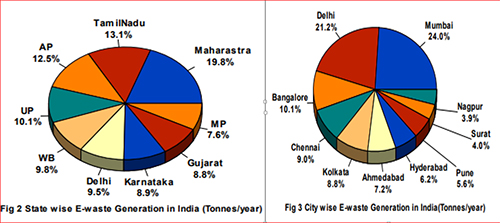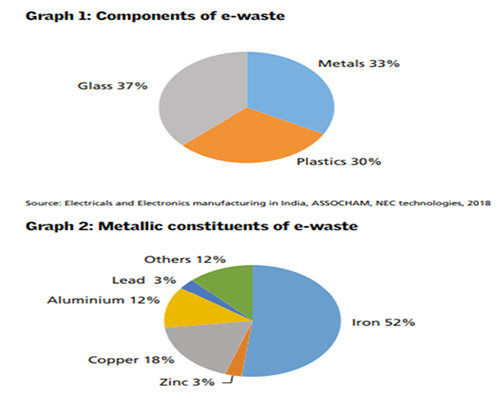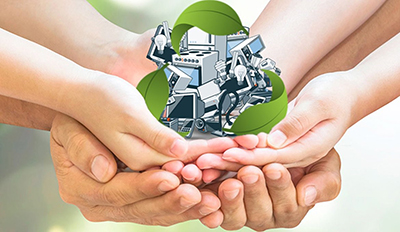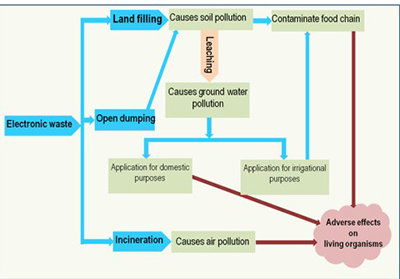Relevance: GS-3: Science and Technology- developments and their applications and effects in everyday life.
Key Phrases: Extended producer responsibility, Electronic waste management rules, e-waste, CPCB, CRTs, PCBs.
Context:
- Recently, the Union Ministry of Environment, Forest and Climate Change made public the draft notification for Electronic waste management rules.
- The rules, which have been put up for public feedback, are expected to come into effect by August, 2022.
Key Highlights:
- Targets: Consumer goods companies and makers of electronics goods have to ensure at least 60% of their electronic waste is collected and recycled by 2023 with targets to increase them to 70% and 80% in 2024 and 2025 respectively.
- The rules bring into effect a system of trading in certificates, akin to carbon credits, that will allow companies to temporarily bridge shortfalls.
- The extended producer responsibility (EPR) certificates certify the quantity of e-waste collected and recycled in a particular year by a company and an organisation may sell surplus quantities to another company to help it meet its obligations.
- Companies will have to register on an online portal and specify their annual production and e-waste collection targets.
- Monitoring authority: Central Pollution Control Board (CPCB) is
the chief entity that coordinates the trade of EPR certificates and monitors
if companies are meeting their targets.
- A steering committee to be headed by the Chairman of the CPCB will oversee the overall implementation of these regulations.

- Non-Compliance: Companies that don’t meet their annual targets will have to pay a fine or an “environmental compensation”, but the draft doesn’t specify the quantum of these fines.
- Provisions to comply at later date: Companies that fall short of
the annual target can meet a year’s target, even after three years.
- Those that meet their targets with a year’s delay will be refunded 85% of their fine, and 60% and 30% after the second and third year, respectively.
- Role of State governments:
- The responsibility of earmarking industrial space for e-waste dismantling and recycling facilities lies with them.
- Establishing measures for protecting the health and safety of workers engaged in the dismantling and recycling facilities for e-waste.

About E waste:
- Electronic waste or e-waste is generated when electronic and
electrical equipment becomes unfit for their originally intended use
or had crossed the expiry date.
- Examples: Computers, servers, mainframes, monitors, compact discs (CDs), printers, scanners etc.
- E-waste typically consists of metals, plastics, cathode ray tubes (CRTs), printed circuit boards, cables, and so on.
- The presence of toxic substances such as liquid crystal, lithium, mercury, nickel, polychlorinated biphenyls (PCBs), cadmium, chrome, cobalt, copper, and lead, make it very hazardous.
- International E-Waste Day has been observed on 14th October since 2018.
Global Scenario:
- The EU legislations restricting the use of hazardous substances in electrical and electronic equipment (Directive 2002/95/EC) and promoting the collection and recycling of such equipment (Directive 2002/96/EC) were enforced in February 2003.
- The legislation provides for the creation of collection schemes where consumers return their used e-waste free of charge. The objective of these schemes is to increase the recycling and/or re-use of such products.
- Major initiatives on RoHS were taken in California, Norway, China, South Korea and Japan. Many countries including Australia, New Zealand, Thailand, Malaysia, Taiwan, Canada and Brazil are also seriously considering the matter.
Current Challenges for e-Waste Elimination:
- Cost of recycling e-Waste exceeds the revenue recovered:
- In many cases, the cost of recycling e-Waste exceeds the revenue recovered from materials especially in countries with strict environment regulations.
- e-Waste Dumped in poor countries:
- e-Waste mostly ends up dumped in countries where environmental standards are low or nonexistent and working conditions are poor.
- Lack of Waste Removal Infrastructure:
- Most developing countries lack the waste removal infrastructure and technical capacities necessary to ensure the safe disposal of hazardous waste.
- Variety of Health Problems:
- e-Waste has been linked to a variety of health problems , including cancer, neurological and respiratory disorders, and birth defects.
Indian Enforcement Agencies involved in E-waste:
- Ministry of Environment Forest and Climate Change, Government of India is responsible for identification of hazardous wastes and provides permission to exporters and importers under the Environment (protection) Act, 1986.
- Central Pollution Control Board (CPCB) was constituted under the Water
(Prevention and Control of Pollution) Act, 1974.
- CPCB coordinates activities with the State Pollution Control Boards and ensures implementations of the conditions of imports.
- It also monitors the compliance of the conditions of authorization, import and export and conduct training courses for authorities dealing with management of hazardous wastes.

Ways to Manage e-Waste:
- Store Data Online:
- By storing data online, we can still access our data from anywhere around the world, without the need to carry a storage device at all times.
- Cloud storage also gives us a large amount of storage, for free or very cheap.
- Buy Energy Star Rated Electronics:
- A high Energy Star rated device consumes less energy, reducing our electricity bill significantly.
- In addition, because less energy is required, it keeps a check on resource (energy) depletion by avoiding over-utilization.
- Spread awareness:
- Proper education, awareness and most importantly alternative cost effective technology need to be provided so that better means can be provided to those who earn their livelihood from this.
Conclusion:
- A holistic approach is needed to address the challenges faced by India in e-waste management. A suitable mechanism needs to be evolved to include small units in unorganized sector and large units in organized sector into a single value chain.
- E-waste contains hazardous substances that are harmful to the environment and human health if not properly treated or disposed of, therefore they must be handled with care.
Sources: Meity.Gov
Mains Question:
Q. What are e-Waste Laws? Suggest methods to manage e-waste in India. (250 Words).








